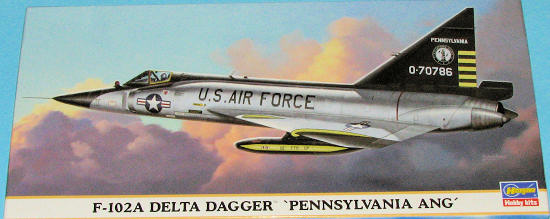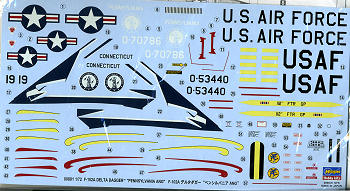
Hasegawa 1/72 F-102A Delta Dagger "Pennsylvania ANG"
| KIT: | Hasegawa 1/72 F-102A Delta Dagger 'Pennsylvania ANG' |
| KIT #: | 00891 |
| PRICE: | $ |
| DECALS: | Two Options |
| REVIEWER: | Scott Van Aken |
| NOTES: | A real oldie this time |

| HISTORY |
The F-102 was developed from the XF-92A delta wing research aircraft of the late 1940s. The Air Force took a new approach in putting out the request for proposals for an operational interceptor, considering both the aircraft and armament together in what became known as a "weapon system". The RFP for Project MX-1554 went out 18 June 1950, and in January 1951 six manufacturers responded, of which Convair, Lockheed, and Republic were chosen to proceed with design. Three of these projects were too expensive, and in November, only Convair was allowed to continue with its Model 8-80, an interim project using the less-powerful Westinghouse J40 turbojet in lieu of the Wright J67 which was still in development.
The YF-102 made its first flight on 24 October 1953, but was lost to an accident nine days later. The second aircraft flew on 11 January 1954, confirming a dismal performance: Approximately 812 mph, while supersonic, it was far below the requirements. The problem was solved by the use of the area rule, which entailed narrowing the aircraft down in the mid-section, moving the cockpit and intakes back further, blending the outer contours of the intake duct, lengthening the nose and adding two fairings on either side of the engine nozzle, resulting in the new "'YF-102A design'". The new design was more than twice as fast as the non-area ruled design. The "'YF-102A'", however was not exactly the same as the production F-102A design in that its nose was considerably longer than the "'F-102A.'
Somewhere along the way, the Wright J-67 was cancelled, and the J-40 was replaced with a Pratt & Whitney J-57.
The production F-102A had the Hughes MG-3 fire control system, later upgraded in service to the MG-10. It had a three-segment internal weapons bay under the fuselage for air-to-air missiles. Initial armament was three pairs of GAR-1 Falcon missiles, a mix of infrared and semi-active radar homing. The doors of the two forward bays each had tubes for 12 x 2.75 in FFAR rockets (for a total of 24). The F-102 was later upgraded to allow the carriage of a GAR-11 Nuclear Falcon missiles in the center bay. The larger size of this weapon required redesigned center bay doors with no rocket tubes. Plans were considered to fit the MB-1 Genie nuclear rocket to the design, but it was never adopted.
Because of the changes that had to be made in redesigning the aircraft with the area rule in mind, the ambitious plan to produce the production aircraft on the prototype tooling had to be abandoned; two-thirds of the 60,000+ pieces of tooling had to be scrapped or heavily modified.
To train F-102A pilots, the TF-102A trainer was developed, with 111 eventually manufactured. The aircraft was fitted with a side-by-side cockpit to facilitate ease of pilot training. This required a redesign of the cockpit and nose incorporating a set of vortex generators on the top of the cockpit to prevent flow separation under certain circumstances, and repositioning of the intake ducts. Despite the many changes, the aircraft was combat-capable, although this variant was predictably slower, only reaching subsonic speeds in level flight.
The F-102's direct successor was the related F-106 Delta Dart, which was originally designated YF-102B. The design underwent so many aerodynamic changes including a larger J-75 turbojet and a variable-geometry inlet design that it essentially became an entirely new plane.
The F-102A provided years of service in Fighter Interceptor Squadrons with the USAF and ANG. It only fired its weapons in combat during ground attack missions in Vietnam in the mid 1960s using its FFAR rockets, which were, by all accounts, quite a devastating weapon if on the receiving end.
| THE KIT |
We are going to have to step into the way-back machine for this one as the F-102 and other Century Series fighters were part of Hasegawa's initial kit releases in the late 1960s. Despite the hope of newer modelers that Hasegawa would have retooled the kit (yeah, right), this has not happened. We are left with thick plastic, somewhat dodgy fit, raised panel lines, rivets and extremely basic construction.
Cockpit has a slab ejection seat and pilot to fit into a generic tub. Side consoles are provided as decals, something I believe is somewhat recent as I don't recall the initial releases having these. The instrument panel is also provided a decal. The nose gear well is enclosed, but that is not the case with the main gear. The kit provides a weapons bay with the missile rails in the extended position. There are four doors to attach. No closed bay option is provided, though I believe Aeroclub makes a one-piece insert if so inclined. Though 'Falcon' missiles are provided, they are really just shapes and  should be replaced from a weapons set. Two drop tanks are provided. The one-piece canopy is not that well molded and has indistinct frame lines. However, since there is no really good interior, you may as well use it. Those of us who have built this kit will tell you that the fit of the intakes and the small section that goes into the fin is not good. These can be overcome by sanding and dry-fitting prior to applying the cement.
should be replaced from a weapons set. Two drop tanks are provided. The one-piece canopy is not that well molded and has indistinct frame lines. However, since there is no really good interior, you may as well use it. Those of us who have built this kit will tell you that the fit of the intakes and the small section that goes into the fin is not good. These can be overcome by sanding and dry-fitting prior to applying the cement.
Instructions are for the last boxing from the 80s which was a California ANG plane. The new decals and markings are separate. These are for the box art plane from the 146 FIS Pennsylvania ANG with its fetching black tail and spine, and for the equally nice 118 FIS Connecticut ANG with its eagle motif on the tail The decals look to be excellent and have white whites and the proper red shade. All the bits for the wing fence colors are also provided. These should work quite well with your favorite setting solutions.
| CONCLUSIONS |
Well, it is an ancient kit and does need to be replaced with something more modern. However, if you do not have an F-102 in your collection, then this would be an excellent boxing to have. This kit does not get reissued very often so get one now while the getting is good.
I would be remiss if I did not mention this. The Hasegawa kit has the earlier Case X wing. The Case XX wing has a decided downward curve on the wing tip. The Case XX wing was installed starting with aircraft 56-1317 and not retrofitted to earlier planes. This means that the box art plane, serial 57-0786 cannot be accurately built because of the wing provided by the kit. The Connecticut ANG plane is serial 55-3440 so can be built using the kit's wing. Choice is yours and most modelers would not notice the difference.
| REFERENCES |
My thanks to www.dragonmodelsusa.com for the review kit. Get yours at your favorite shop or ask them to order it for you.
March 2008
If you would like your product reviewed fairly and fairly quickly, please contact the editor or see other details in the